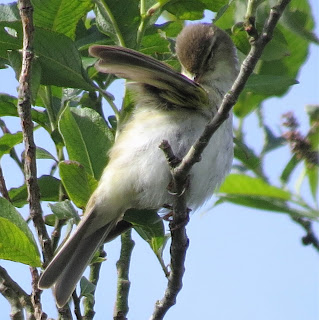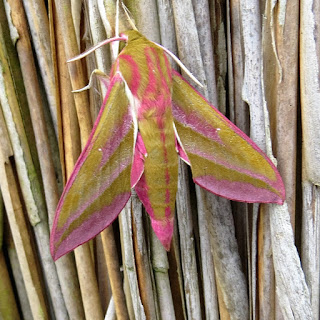Arriving at Strumpshaw this morning, I met Ben (one of the reserve's wardens) carrying a moth trap to the office. Oh good, I thought, maybe he'll have a hornet inside one of them. This large wasp is still one of my targets for my challenge and the bright light of the traps often attract one or two inside. But I was told to wait until 9:30am to see what was inside these traps as Ben was preparing them for a moth group. So, to kill some time, I went for a walk to try and find common blue butterflies, which Ben tells me are easy to find at the moment. Not true. I looked and I looked, but still no sign of them anywhere.
 |
| Tree Bumblebee |
I have ten targets left on my Strumpshaw 40 challenge, which consists of 5 insects; hornet, water scorpion, common blue butterfly, willow emerald damselfly and dark bush cricket, 2 fungi; candlesnuff and shaggy inkcap, 1 plant; milk parsley (which I am waiting to flower) and 2 tricky others; water rail and weasel. The latter two are going to be the hardest to find let alone photograph. But at least I have plenty of time to find them as they are around all year round. For the other targets, however, I have up until the end of summer to find them all and a handful of them, such as the fungi, are still yet to emerge. So I have at least 3 out of 5 insects to hunt for this morning.
 |
| Grey Heron |
 |
| Dark Bush Cricket (31) |
To my surprise then, when I found this dark bush cricket amongst the nettles alongside the river trail. This was a target I was expecting to emerge next month, it seems to have appeared a month early. Then I noticed that this was only a small one, which indicates that it is still a youngster and still has a lot of growing to do until it is fully grown. This is what is known as a nymph. This nymph will shed its skin a few more times, becoming larger each time. Adults can grow to about 20mm, big enough to fit in the centre of the palm of your hand with antennae as long as one of your fingers. And that is what distinguishes crickets from grasshoppers, their long antennae. They also chirp by rubbing their 'shoulder blades' on their backs, while grasshoppers don't. When fully grown, dark bush crickets are impressive looking insects, so though I can tick it off my list, I will continue searching for a bigger one.
 |
| Cardinal Beetle |
 |
| Nursery Spider (I think) with egg sac |
 |
| Willow Warbler |
 |
| Meadow Brown |
 |
| Moth watching |
After returning from my walk, I learned that I had just missed an otter outside the Reception Hide! I may have already ticked it off, but I never tire from seeing an otter again and again. Oh well! It was now time for the moth event and to see if a hornet was caught. There were about four traps to rummage through and Ben had a large audience of moth enthusiasts to help him out. Unfortunately, there were no hornets in any of the traps. However, there were still some beautiful moths to look at, including a few hawk-moths and buff-tips. Some of these highlights were later displayed on the blind beside the Reception Hide for other visitors to see and photograph.
 |
| Elephant Hawk-moth |
 |
| Poplar Hawk-moth |
 |
| Eyed Hawk-moth |
 |
| Poplar Hawk-moth and Buff-tip on someone's hand |
 |
| Buff-tip |
 |
| Small Angle Shades |
 |
| Grey Heron |
From Reception Hide, there were several bearded tits darting across the broad into the reedy islands, where they teased my colleague on shift with me today as she really wanted to see one, but kept missing them. I also saw hobbies, marsh harriers, a kingfisher briefly, a Chinese water deer feeding amongst tall reeds close to the blind, swallows and a few herons. I also found this common spotted orchid. Then the sun disappeared behind thick clouds and the warm air felt as if it was being sucked upwards. The forecast is that there is going to be a thunderstorm later today. Not taking any chances, I decided to head for home rather than searching for blue butterflies, hornets and water scorpions.
 |
| Common Spotted Orchid |

 |
| Hoverfly Volucella Pellucens |
 |
| Great Crested Grebe |


























No comments:
Post a Comment